Exhibitions, Projects
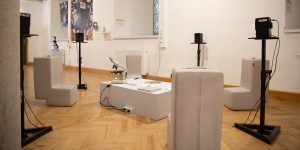
TARDIGRADA – von mikrobiotischen Lebenskünstlern
Maria Antonia Schmidt (DE)
The tardigrade or water bear, a microorganism, survives environmental conditions that hardly any other living creature can withstand. While researchers are working on deciphering the secrets of the tardigrade's survival, the media are throwing themselves at the cute bear and marketing it in all conceivable variations. In the end, the work poses the question of what sound these tiny creatures make. This is reason enough for the world's first tardigrade nano-ear experiment: a musical radio feature/4channel audio installation between science and absurdity.
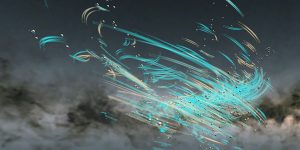
Light
University of Applied Sciences Würzburg-Schweinfurt, Faculty of Design
Light in its essence is not perceivable. Only in combination with shadow can humans experience it. It is therefore often used as a symbol for the immaterial. While the sciences explain light as a physical phenomenon, it is used metaphorically for very different contents in the humanities. Both concepts provide interesting impulses for entirely diverse approaches to projects. In this course, we looked into the subject “light” in form and content in a very versatile, innovative and experimental way.
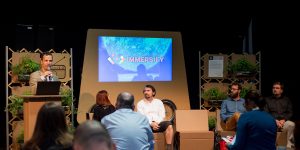
Immersify – Frontiers of European Media Creation
Panel Discussion
Immersive media let us dive deep into images and videos – sometimes to the point where we completely forget the world around us. In order to transform this new kind of media from a niche phenomenon to widespread practice, the Ars Electronica Futurelab and four partners from all over Europe are working on a common research project, Immersify. At the Panel Discussion at the Open Futurelab, project partners and involved artists gather to speak about the new generation of immersive media applications.
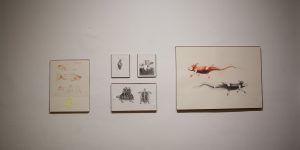
The Poetic Design: From Mimesis to Catharsis.
Homero Ruiz (MX/DE)
The Poetic Design: From Mimesis to Catharsis explores the visual poetry and basis of Greek aesthetic philosophy through its four main elements: Mimesis, Poiesis, Apate (Esthetic Illusion), and Catharsis.
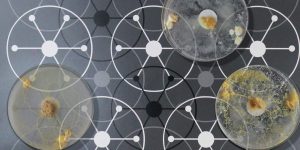
Slime Mold Chess
Hakan Lidbo (SE)
This game is a collaboration between one of our planet’s most simple forms of intelligence and the most advanced. Slime mold and humans.
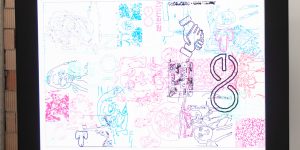
The Graffiti Project
The Graffiti Project is a live, collaborative, interactive, token-driven art installation. Participants are able to upload their creative content through the æternity digital graffiti æpp, leveraging blockchain’s core features of a public, decentralized, distributed record to archive indefinitely an artwork that would normally be local and temporary and make it accessible by a global audience.
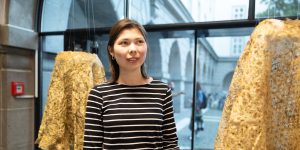
Rhizomes
Freya Probst (DE/UK)
These grown gowns are the outcome of a series of experiments and playful interactions with plants and the observation of their roots through photography or time-lapse video. Experiments with pearls, small gears, or the positioning of seeds lead to different plant responses. The outcome was eventually applied to larger surface areas in the shape of cutting patterns reminiscent of fine woven textiles. The exhibits show a subterranean, hidden aesthetic of a natural structure that cannot be copied by humans.
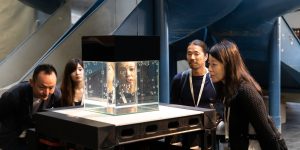
(un)shaped
Takayuki Hirai (JP), Yasuaki Kakehi (JP)
This installation utilizes antibubbles in water as a medium. Through computationally controlled droplets, the antibubbles form various patterns on the water’s surface. Then they start to float in the water and disappear after a while. These periodic phenomena shows continuous morphing from computationally controlled forms to organic ones mediated by the environment.
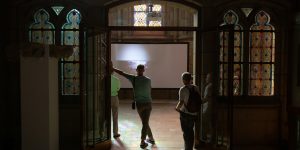
Calle 22
Julius von Bismarck (DE)
Calle 22 is Julius von Bismarck's documentation of the street of the same name in Bogotá, Colombia. With a high-speed camera and a spotlight, he shoots over 2500 frames per second during a high-speed car along its south side at night. This takes him from the prosperous parts of town to its poor quarters, allowing him to present urban development in a very compressed space, and to reflect on the city’s political process by travellikng down a single road.
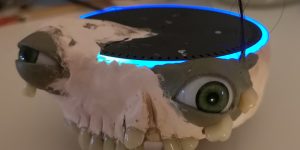
Into The Distance
University of the Arts London, London College of Communication, MA Interaction Design Communication (UK)
In dieser Ausstellung setzen wir uns für eine Zukunft ein, in der wir die Dinge anders und besser machen als in der Vergangenheit. Die Vergangenheit der „digitalen Revolution“ im Geiste von Hartleys Zitat zu sehen, bedeutet nicht, sie zu verleugnen; es ist eine Gelegenheit, eine neue Sichtweise von ihr zu entwickeln, eine Chance, über ihre Trends und gescheiterten Versprechen aus heutiger Perspektive zu reflektieren. Wir können unseren Blick weiter in die Ferne lenken, sowohl hinter als auch vor uns; um zu erforschen, wie ältere (oder antike) Ideen und Konzepte zu wirkmächtigen kritischen Werkzeugen werden können, um aktuelle und zukünftige Herausforderungen zu ergründen.


